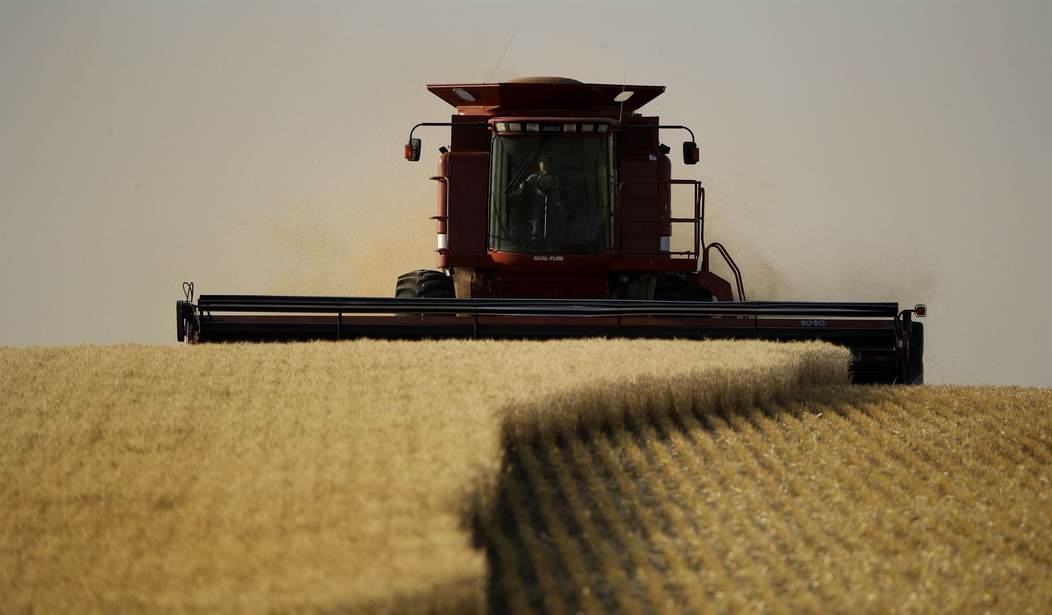As any of you who have been reading my work for longer than it takes to click a link with a mouse knows, I'm fond of pointing out a principle of technological progress: We solve today's problems with tomorrow's technology. This doesn't just apply to today, either. It's been around since the first time some guy found out that a sharp rock allowed him to skin an antelope a lot faster than by just using his teeth.
Back in the late 1960s, there was a lot of concern about global food supplies. I remember (vaguely; I was very young) news stories about famines in the Third World, in places like India and parts of Africa. But those problems, even back then, were largely addressed by new crops, by new practices, developed in what became known as the Green Revolution. Crop yields went up dramatically, while the amount of land taken up by agriculture didn't change much. It was a remarkable time in agriculture and in biology.
Now, though, decades later, environmental and climate activists are downplaying the impact of the Green Revolution - or denying it altogether. Stuart Smyth is Professor in the Department of Agricultural and Resource Economics at the University of Saskatchewan, and he has some facts to lay on us.
In the past few years, many environmental and academic activists have been undermining the work of Norman Borlaug and the successes of the Green Revolution by publishing false information. The environmental activists behind these headlines claim that the Green Revolution failed. Here is a random sample of examples of these activists lying to the public.
Let's look at the lies. First, we go to India, in the late 1960s.
These activists ignore the fact that new wheat varieties developed by Norman Borlaug saved millions of people from starving to death, especially in India. Dr. Borlaug’s wheat is still to this day revered for “reversing the food shortages that haunted India and Pakistan in the 1960s”. While it was not easy for him to convince the locals of his development program of higher-yielding, disease resistant cereal crops that were well suited for humid climates, rather than their Indigenous crops that were not adopted to meet the local food demands or changing environmental pressures, such as stem rust and drought-like conditions.
Fortunately, evidence easily refutes the misinformation spread by such activists’ claims. Wheat yields rose dramatically in the late 1960s and throughout the 1970s. By lying to their audience and the public, these groups are ignoring that wheat yields in India more than doubled between the period of 1967 and 1972.
Norman Borlaug was a pioneer in developing new crops, particularly disease and drought-resistant strains of wheat. He was, in many ways, the father of the Green Revolution.
The world's 1950 grain output of 692 million tons came from 1.7 billion acres of cropland, the 1992 output of 1.9 billion tons from 1.73 billion acres -- a 170 percent increase from one percent more land. "Without high-yield agriculture," Borlaug says, "either millions would have starved or increases in food output would have been realized through drastic expansion of acres under cultivation -- losses of pristine land a hundred times greater than all losses to urban and suburban expansion."
His work also bore great fruit in Mexico:
Norman Borlaug was able to develop shorter, higher yielding wheat varieties that were rapidly adopted throughout many food insecure parts of the world. Similarly, wheat production in Mexico dramatically increased between 1972 and 1976. Wheat production increased during these periods from the higher yielding varieties that were developed, but also through improved understanding of the importance of fertilizer applications. Governments were able to import greater volumes of fertilizer, arrange for it to be distributed throughout the country, and allow farmers to increase the amount of essential crop nutrients applied to their fields.
There’s no “new research” as claimed by the above activist headlines. The evidence is clear: the Green Revolution resulted in higher crop yields that contributed to preventing one billion deaths from starvation. Dr. Borlaug made an amazing contribution to improving global food security. In 1970, he was awarded the Nobel Peace Prize for his work.
Wheat yields in Mexico from 1960 (Note particularly the years 1972-1976) to date show significant increases:
Wheat yields in Mexico, 1960-present pic.twitter.com/WbgqTTJl7q
— Ward Clark (@TheGreatLander) August 26, 2025
Again, these are facts.
Read More: This Is Good: CO2 Causes Plant Growth, Global Greening
AP Claims Farmers Need Government to Shield Them From Climate Change. They Don't.
The "green" activists and environmental shouters, many of whom have very little contact with the actual environment, are constantly calling for the need for more small-scale, "organic" farming. That's a canard; worse, it's a first-world luxury, only practical for wealthy developed nations. Organic farming that eschews things like modern fertilizers and modified crop plants is limited in land space; the only way to increase yields, if one is ruling out advanced plant breeds, is to increase the amount of land used.
Modern scientific crop breeds reverse that; they increase yields while, at the very least, using the same amount of land - if not actually less. Dr. Smyth has those numbers as well, and they prove the activists are dissembling:
As I see it, activists who are opposed to the commercialization of specific innovative crop varieties, are often in favour of small-scale organic crop production. Now, there is nothing wrong with this, but if the goal is to be high yielding or address specific crop needs, small-scale organic production is only able to produce more food by using more land, as illustrated below by the Organisation for Economic Cooperation and Development. In the early 1960s, at the start of the Green Revolution, coupled with increased fertilizer use and more efficient pesticide use, crop yield increases were decoupled from increased land use.
— Ward Clark (@TheGreatLander) August 26, 2025
In other words, the Green Revolution was an unqualified success. It came from actual science, carried out by actual scientists, and the crops developed have almost certainly saved millions of lives.
The great thing is that it's still going on today. Yields per acre are still increasing, and the rise of new crops is speed boosting that trend.
On average, GM technology adoption has reduced chemical pesticide use by 37%, increased crop yields by 22%, and increased farmer profits by 68%. Yield gains and pesticide reductions are larger for insect-resistant crops than for herbicide-tolerant crops. Yield and profit gains are higher in developing countries than in developed countries.
This is what science, properly done, can do. This is how work done under the scientific method, in this case, work in biology, can greatly improve even global standards of living. This is how it's supposed to work. The activists, climate scolds, and environmentalist loons who are now denying the benefits of the Green Revolution should be countered with facts; fortunately, the facts are on the side of modern agriculture.
We solve today's problems with tomorrow's technology. That's how it's always been. With any luck, if we continue to develop, to innovate, to create, that's how it always will be.














